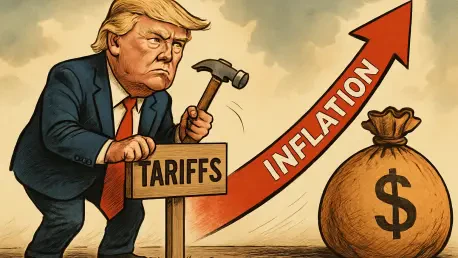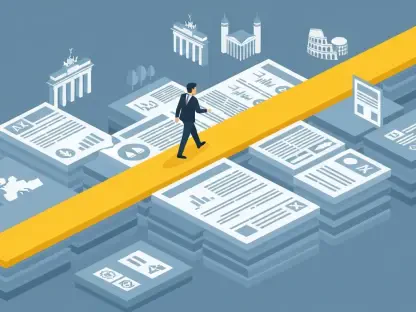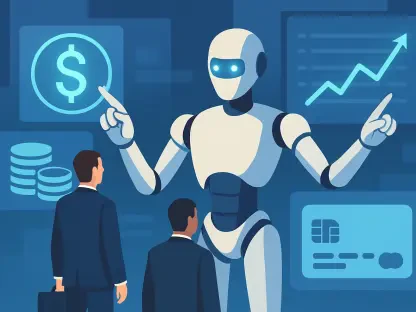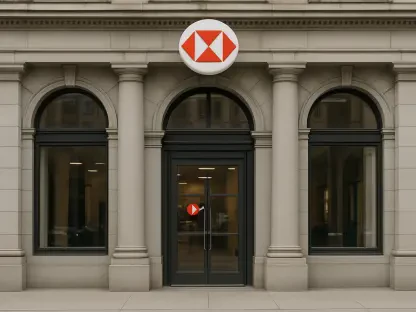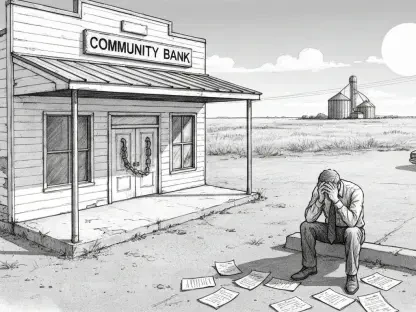In the current economic landscape of 2025, the United States finds itself grappling with persistent inflation that refuses to align with the Federal Reserve’s long-standing 2% target, creating a challenging environment for consumers and policymakers alike. As of July, the annual inflation rate holds steady at 2.7%, a figure that, while down from its alarming 2022 peak, still signals ongoing price pressures impacting household budgets across the nation. This lingering issue is compounded by new economic headwinds, particularly policy decisions that are beginning to reshape the cost of everyday goods. The struggle to achieve price stability has become a central concern, with American families feeling the pinch in their wallets as they navigate rising expenses. Amid this backdrop, a key factor has emerged as a significant driver of these price increases, raising questions about the sustainability of current economic strategies and their long-term effects on affordability.
Beyond the raw numbers, the broader implications of inflation are starkly evident in the diminished purchasing power that has accumulated over recent years, highlighting a critical economic challenge. Since February 2020, consumer prices have surged by a staggering 24.3%, meaning that what once cost $1,000 now demands roughly $1,243—a clear illustration of the burden placed on everyday Americans. This erosion of value underscores the urgency of addressing inflationary trends, especially as new policies add layers of complexity to an already fragile recovery. The following sections delve into the specific forces at play, examining both the immediate and potential future impacts on the economy while offering insights into how consumers and authorities are responding to these challenges.
Unpacking Inflation Dynamics
Persistent Price Pressures
Inflation’s stubborn grip on the U.S. economy remains a pressing issue as the annual rate sits at 2.7% in July 2025, consistently above the Federal Reserve’s desired 2% benchmark. Even more concerning is the core inflation rate, which strips out the volatile food and energy sectors, registering at 3.1%. This discrepancy highlights a deeper, more entrenched problem within the pricing structure of essential goods and services. While the dramatic spikes seen in 2022 have moderated, the uneven progress toward stability suggests that the path to the Fed’s target is far from straightforward. For many households, this persistent inflation translates into a daily struggle to maintain their standard of living, as wages often fail to keep pace with rising costs. The reality is that even a moderated inflation rate can erode financial security over time, making every purchase a calculated decision for millions of Americans.
The cumulative effect of price increases since the onset of the pandemic further paints a grim picture of economic strain, with a 24.3% surge in consumer prices since February 2020. This means that the cost of living has dramatically outstripped pre-pandemic levels, placing an undeniable burden on family budgets. This long-term trend is not just a statistic but a tangible barrier to savings and financial planning, as essentials eat up a larger share of income. Unlike short-term price fluctuations, this sustained rise reflects systemic challenges that have yet to be fully addressed, from supply chain bottlenecks to labor market dynamics. As the economy continues to recover from past disruptions, the lingering impact of these price hikes serves as a reminder of how deeply inflation can reshape consumer behavior and expectations.
Other Forces Fueling Inflation
Beyond policy-driven factors, several underlying elements continue to propel inflation, with shelter costs emerging as a dominant force, accounting for 48% of the annual price increase. This significant share reflects the soaring costs of rent and homeownership, which weigh heavily on household expenditures. Additionally, food prices contribute 14% to the inflationary trend, while motor vehicle insurance adds another 6%, driven by rising repair costs and risk assessments. These sectors collectively create a formidable challenge for consumers already stretched thin by broader economic pressures. The reality of these cost drivers is evident in grocery stores and monthly bills, where families are forced to allocate more resources just to maintain basic needs, often at the expense of discretionary spending or savings goals.
Specific categories of goods have experienced particularly sharp increases, further exacerbating the financial strain on Americans, especially as they struggle to afford everyday necessities. Eggs, for instance, have skyrocketed by 86.5% since 2020, while beef products have also seen substantial hikes, making staple foods a luxury for some. In contrast, certain items like smartphones and televisions have become more affordable due to improved supply chains and technological advancements, offering a sliver of relief. However, these price drops in select categories do little to offset the broader trend of rising costs for necessities. The disparity between inflating essentials and deflating non-essentials highlights the uneven impact of economic recovery, where gains in efficiency fail to translate into widespread affordability for the average consumer facing persistent budgetary constraints.
Tariff Policies and Economic Impact
Rising Costs from Import Taxes
A pivotal factor contributing to the current inflationary environment stems from the recently implemented tariffs under President Donald Trump, which rank among the highest since the Great Depression. These import taxes have directly influenced the prices of a wide range of consumer goods, from everyday staples like coffee and tomatoes to discretionary items such as toys and apparel. The immediate effect is clear in the data, with core goods prices—excluding food and energy—accounting for 20% of the monthly inflation increase between June and July 2025. Businesses, faced with heightened costs due to these tariffs, have begun passing the burden onto consumers, resulting in noticeable price hikes at checkout counters. This trend marks a shift in economic dynamics, where external policy decisions directly impact the cost of living for millions of households across the country.
The ripple effects of these tariffs are not limited to specific products but extend to broader market behaviors, as companies adjust their pricing strategies to absorb or offset the added expenses. Retailers and manufacturers, squeezed by the increased cost of imported materials and goods, often have little choice but to raise prices, thereby fueling inflation at the consumer level. This pass-through effect is particularly concerning for low- and middle-income families, who spend a larger proportion of their income on tariff-affected goods. As these price increases become embedded in the economy, they risk creating a feedback loop where higher costs lead to demands for higher wages, which in turn could drive further inflation. The early signs of this cycle are already visible, underscoring the immediate and tangible consequences of trade policies on daily life.
Long-Term Inflationary Threats
Looking ahead, the full scope of tariff impacts remains a looming uncertainty, with many economists cautioning that the worst may be yet to come, as the long-term effects are still unfolding. A survey by Bankrate indicates that 41% of economic experts anticipate inflation remaining elevated through 2027 due to these import taxes, suggesting a prolonged period of price pressure. The delayed effect of tariffs often means that initial cost increases are just the tip of the iceberg, as supply chains and pricing models take time to fully adjust to the new trade landscape. This potential for further price hikes poses a significant risk to economic stability, especially as businesses continue to grapple with the cumulative burden of higher import costs over the coming months and years.
The broader implications of sustained inflation driven by tariffs could reshape consumer confidence and spending patterns in profound ways. If prices continue to climb without corresponding wage growth, discretionary spending may decline, slowing economic growth and potentially triggering a cycle of stagnation. Policymakers face the daunting task of balancing trade objectives with domestic price stability, a challenge made more complex by global economic interdependencies. The consensus among analysts is that without mitigating measures—such as targeted exemptions or alternative trade agreements—the trajectory of tariff-induced inflation could undermine recent progress in cooling price pressures. This uncertainty casts a long shadow over the economic outlook, demanding vigilance and adaptability from both government and private sectors.
Monetary Policy Challenges
Hesitation on Interest Rate Adjustments
The Federal Reserve finds itself navigating a delicate balance in 2025, having paused further interest rate cuts after a notable 1% reduction across three meetings in 2024, setting the benchmark rate at a range of 4.25-4.5%. This cautious stance reflects deep uncertainty surrounding the inflationary impact of recent trade policies, particularly tariffs. After aggressive rate hikes to combat the 2022 inflation peak, the Fed’s shift to cuts last year aimed to ease borrowing costs and stimulate growth. However, the resurgence of price pressures tied to external factors has prompted a reevaluation of that strategy. Officials are now prioritizing close monitoring of economic indicators, wary of prematurely loosening monetary policy in a climate where inflation remains above the 2% target and new risks continue to emerge.
This hesitation underscores a broader tension within monetary policy circles, as the Fed grapples with the conflicting goals of curbing inflation while supporting economic expansion. The pause in rate adjustments signals a preference for stability over rapid intervention, especially given the unpredictable nature of tariff-driven cost increases. High borrowing costs, still lingering from prior rate hikes, continue to impact consumers and businesses, limiting access to credit for major purchases or investments. Meanwhile, the Fed’s data-dependent approach means that any future moves will depend on clear evidence of inflation trends, potentially delaying relief for those burdened by high interest on loans and credit cards. This wait-and-see posture reflects the complexity of managing an economy under strain from both domestic and international pressures.
Variations in Inflation Metrics
Adding another layer of intricacy to the inflation narrative is the divergence between key measurement tools used by economic authorities. The Consumer Price Index (CPI), reported by the Bureau of Labor Statistics, pegs inflation at 2.7% annually, while the Personal Consumption Expenditures (PCE) index, favored by the Federal Reserve, shows a slightly lower rate of 2.6% as of June 2025. This discrepancy arises from methodological differences, such as the PCE’s consideration of consumer substitutions and its lower weighting of shelter costs, which have been a major driver of inflation. While the gap may seem minor, it influences how policymakers and the public perceive the severity of price pressures, often leading to varied interpretations of economic health and the appropriate response.
These measurement variations highlight the challenge of crafting a unified strategy to address inflation, as different metrics can suggest varying levels of urgency that impact decision-making. For instance, the CPI’s higher figure might push for tighter policy, while the PCE’s lower reading could justify maintaining current rates. This inconsistency complicates communication between the Fed, lawmakers, and the public, as each group may prioritize different data points when assessing the economy. Despite these differences, the overarching reality remains unchanged: inflation persists above target levels, and external factors like tariffs continue to muddy the waters. Understanding these nuances is critical for grasping why policy responses may appear fragmented or delayed in the face of mounting economic challenges.
Consumer Realities and Adaptive Measures
Economic Hardship for American Families
For countless American households, the persistent inflation rate, even at its current moderated level of 2.7%, translates into a tangible reduction in financial well-being, akin to experiencing a pay cut without a change in income. The cumulative 24.3% price increase since February 2020 has drastically diminished purchasing power, forcing families to stretch their budgets thinner to cover the same essentials. This ongoing strain complicates efforts to build emergency savings or plan for long-term goals like retirement, as a larger portion of income is consumed by day-to-day expenses. The psychological toll of this economic pressure is significant, with many feeling a sense of uncertainty about their financial future amid rising costs that show no immediate signs of abating.
The impact is particularly acute for lower-income households, where essentials like food and housing—key drivers of inflation—consume a disproportionate share of earnings. Specific price surges, such as those for eggs and beef, hit these families hardest, often necessitating difficult trade-offs between necessities. Meanwhile, the benefits of declining prices in non-essential categories like electronics offer little solace when grocery bills and rent continue to climb. This uneven economic landscape fosters a growing divide, where affordability becomes a daily challenge rather than a temporary setback. As inflation continues to outpace wage growth for many, the erosion of financial stability remains a critical issue that shapes consumer behavior and economic sentiment across the board.
Strategies to Mitigate Rising Costs
Navigating the current inflationary environment demands practical adjustments from consumers seeking to preserve their financial health, and adopting smart strategies can make a significant difference in managing expenses. Comparison shopping across retailers has emerged as a vital tactic, allowing individuals to seek out the best deals on essentials and avoid overpaying due to localized price hikes. Substituting expensive items with more affordable alternatives—such as opting for store brands over name brands—can also yield significant savings over time. Additionally, leveraging high-yield savings accounts, where deposit rates still outpace inflation in some cases, offers a low-risk way to maintain the value of money set aside for emergencies or future needs. These actionable steps empower consumers to take control of their spending in a climate where every dollar matters.
Equally important is the need to manage debt carefully, especially given the high borrowing costs that persist despite the Fed’s rate cuts in 2024. Avoiding carrying balances on credit cards, where interest rates remain steep, is crucial to prevent financial strain from compounding. Utilizing rewards credit cards for purchases can provide small benefits, but only if balances are paid off promptly to sidestep costly fees. For those with the means, locking in savings through certificates of deposit (CDs) at competitive rates can serve as a buffer against inflation’s impact. These strategies, while not a complete solution, help mitigate the immediate effects of rising prices driven by tariffs and other economic forces, offering a pathway to greater resilience in uncertain times.
Building Resilience Through Investment
Looking beyond short-term coping mechanisms, investing remains a cornerstone for outpacing inflation over the long haul, despite the immediate pressures of tariff-driven price increases and sticky inflation trends. Allocating resources into diversified portfolios—spanning stocks, bonds, and other assets—can provide returns that historically exceed inflation rates, preserving and growing wealth over time. While market volatility and high borrowing costs pose challenges, a disciplined approach to investing, tailored to individual risk tolerance and financial goals, offers a proactive way to combat the erosion of purchasing power. This strategy requires patience and a focus on long-term gains rather than reacting to short-term economic fluctuations.
For many, the barrier to entry in investing can seem daunting amid current economic constraints, yet even small, consistent contributions to retirement accounts or low-cost index funds can build a foundation for future security. Financial education plays a critical role here, as understanding market dynamics and inflation’s impact equips consumers to make informed decisions. The reality of rising costs underscores the urgency of such planning, as relying solely on savings without growth potential risks falling behind inflation’s relentless pace. By prioritizing strategic financial decisions now, individuals can better position themselves to weather the ongoing storm of price pressures, ensuring that immediate challenges do not derail long-term aspirations in a complex economic environment.
